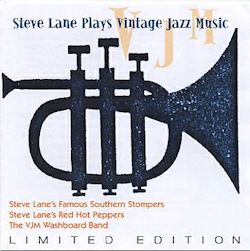
BUY NOW AmazonUK AmazonUS |
STEVE LANE Steve Lane Plays Vintage Jazz Music
|
1. Copenhagen
2. Working Man Blues
3. Zulu’s Ball
4. Mabel’s Dream
5. Just Gone
6. Snag It
7. New Orleans Stomp
8. Elephant Stomp
9. Shreveport Stomp
10. New Orleans Joys
11. Lady Love
12. Mobile Blues
13. The Chant
14. Swampy River
15. New Orleans Shuffle
16. Sau-Sha Stomp
17. Sweetie Dear
18. Sock That Thing
19. Oriental Man
Steve Lane with his following bands:
Steve Lane’s Famous Southern Stompers
Steve Lane’s Red Hot Peppers
The VJM Washboard Band
Recorded between July 6, 1961 and Aug. 14, 1987.
All dates and personnel listed in the booklet notes.
The “Vintage Jazz Music” that Steve Lane played was that of the classic period bands, such as those of King Oliver and Jelly Roll Morton, rather than of the revival period bands, like those of George Lewis and Lu Watters. But despite this preference, Lane was not averse to including in his repertoire pieces by the latter groups and even from outside of jazz. Thus, as John Westwood reminds us, “Steve's repertoire ranged from Jelly Roll, Louis, ODJB, Ma Rainey, Jug/washboard band, Lu Watters, Condon, even Charlie Parker and the Beatles - not to mention classical, opera, military pieces and many others....”
Lane’s primary instrument was guitar, but he took up the cornet after his WWII military service and is most known for that instrument, leading his various bands—the Famous Southern Stompers, the Red Hot Peppers, and the VJM Washboard band—in the collective ensemble style of playing, rather than the ensemble/string of solos/ensemble option. His cornet playing was not brash, but always tasteful and controlled, resulting in bands that quietly swung.
Lane’s groups were all well-rehearsed and “tight,” as the tracks on this CD demonstrate, no matter the frequent personnel changes. His arrangements were always interesting—one can listen to the entire CD at a sitting without any ennui. The opening track, Copenhagen, illustrates these features nicely. Tempi, too, are important. Snag It is played at a slower tempo than usual, playing an important role in establishing the mood of the piece. Shreveport Stomp, invariably played up-tempo, opens here with a very brisk piano solo, that tempo being maintained throughout the rest of the rendition through the closing piano coda, and along the way all musicians execute their parts without any “fluff” or “clam.” A similar treatment is accorded The Chant—quite likely Morton would have approved. Discipline was clearly a core ingredient of Lane’s musical outfits.
Endings of tunes were always appropriate. Swampy River—a fairly obscure Ellington composition not often covered by many other bands, is a case in point. After alternating choruses of straight four and latin, which in itself lends interest, the fading ritard at the closing is a most suitable rounding off. Or the tricky stop time that ends Sau-Sha Stomp, another rarely performed number, leaps out as it closes the killer pace at which the band has played the track.
And there are other jewels, such as Terry Vincent’s humor to be found in his drumming in New Orleans Stomp, his judicious use of wood blocks and choke cymbal in The Chant, or the growl trombone work of Bob Hunt in New Orleans Shuffle. Each track has its moment(s), and one can discover these with repeat playing of the disc, an enterprise that is a pleasure rather than a chore.
One strange omission on this compilation is the lack of female vocalists. Most of Lane’s albums included one, at least, such as Pam Heagren, Pam White, or Rusty Taylor, to mention just a few that he featured at one time or another. Also missing here is any Lane original composition.
According to some, Lane was enigmatic and somewhat difficult at times, which may account at least in part for his ever-changing personnel. But there can be no denying that he was as very good bandleader who brought out the best in his players. As well as leading the various bands and composing no small number of tunes, he also played key roles in the establishing of the VJM record label, the Jazz Guide, and the British Jazz Society and Jazz Times, all of which undoubtedly gave him satisfaction.
Lane never ventured outside of London; hence his bands were never as well known, perhaps, as those that did. Yet his recordings on his VJM label did reach the “provinces” and beyond, so undoubtedly some readers of this review will be familiar with him. Those who are not will get a good sample from this CD (and more on a companion one: Remembering Steve Lane, Lake LACD 347).
Bert Thompson